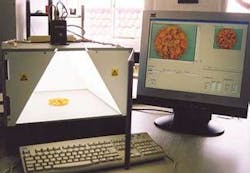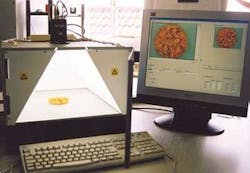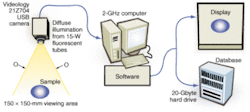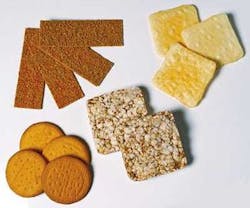Vision system checks food color
Stand-alone vision system confirms that processed food meets user-specified appearance criteria.
By Matthew Peach, European Contributing Editor
Sight is the primary sense when selecting food, ahead of smell, according to Nick Barnes, technical director of Tintometer, a company specializing in color analysis and measurement. If food products do not have consistent color, consumers may suspect a quality problem or that the food is spoiling. The result of consumer dissatisfaction could be significant financial losses to either food producers or retailers.
The Tintometer Colour Appearance Measurement (CAM)500 system was developed to check for color consistency in food products. It integrates camera, light source, and processing power into a system that measures color to determine if food is cooked properly (see Fig. 1). The system is the result of a year-long project between Tintometer and camera-distributor and integrator Alrad Instruments. Geoff Smith, Alrad marketing manager, says, “The project started about six or seven years ago when Alrad was contacted by a company in the Northern Foods Group that wanted to look at baked products. We built a prototype to assess the color of the food. After the delivery of that system, Northern Foods became interested for other applications.”
PROBLEM SOLVING
“The key problems to solve with a food-analysis system are that food is not flat, the colors are not uniform-even when the product is optimally produced, and the materials are often wet. We are working to resolve the problems of analyzing glossy samples. For example, the increasingly popular fast meals can be very oily, which means the surface can act just like a mirror,” says Barnes.
Tintometer marketing manager Jan Bradford says, “You do not need to become an image-processing expert to derive the product information you need to verify the acceptability of food. The CAM500 has a complex capability in the background, but it is easily operated by a food worker, rather than requiring the constant attention of a Ph.D.” It can be used across a range of foods-anywhere there is a color change that needs to be identified. Northern Foods is now looking at applications such as for yogurts, fast foods, and sauces.
The system can look at whole surfaces and make comparative measurements. The operator can analyze down to a spot diameter of 8 mm, but generally this system quantifies an overall impression of the appearance of cooked goods.
The Alrad system includes the Videology 21Z704 USB camera, which has a 1/4-in. Sony interline color CCD, along with autofocus and 16X optical autozoom functions that can be remotely controlled by a PC attached by a USB 1.1 link. A dedicated PC processes the data from the tests, since the food industry prefers to have stand-alone test equipment that does not require attachment to a separate PC. The PC is based on an Intel P4 processor running at 2 GHz with a 20-Gbyte hard disk, as well as a CD writer (see Fig. 2).
Alrad’s Smith says, “Originally, we were running our own software, but when we went into partnership, Tintometer was getting feedback from its potential clients in the field, so we modified the package.” Tintometer now uses MVTec Software’s Halcon package, including its “Active Tools,” which contains all the required image-analysis functions. The user interface was written in Visual Basic 6.0, which is connected to the Active Tools libraries.
The food sample is placed underneath the camera on a removable, wipe-clean tray support, which can be mid-gray, black, white, or other color, depending on the sample and its color/contrast requirements. The system identifies the product and the background by their respective color characteristics.
SYSTEM ILLUMINATION
Tintometer’s Barnes says, “The main variable is the lighting. We have achieved 98% even light distribution over the approximately 150 × 150-mm2 viewing area.” The required lighting quality is achieved by the use of high-frequency, daylight-corrected, fluorescent-tube lighting. The lighting is controlled by an off-the-shelf Omnitronix FL2118-36 M electronic ballast, making replacement easy. Rather than using a cold cathode, the CAM500 uses full spectral lighting that gives daylight-equivalent illumination by 15-W fluorescent tubes.
The secret of the consistency of the illuminated sample is in the diffuser arrangement, according to the developers. The diffuser is an opaque polyester material that offers about 70% translucency. Performance of this material is the key to the success of the device, according to Tintometer.
To test the evenness of the illumination during the development process, a grid of 20-mm2 squares was drawn on a piece of white paper. A reflectance spectrophotometer measured each square, then the paper was placed in the CAM500 and an image taken. Each square of the grid was analyzed and the total deviation compared to the spectrophotometer.
Two diffusers are set at an angle of approximately 60° under the two 15-W tubes positioned above the sample area on either side of the camera, which itself points vertically down. “General practice in this sector is that the two diffusers and the sample’s display plane form an approximate equilateral triangle,” says Barnes. The two 15-W tubes deliver the right combination of light for the power demand.
Tintometer color scientist Hong Xu says, “The intensity of the illumination is based on the camera’s ability to enable a satisfactory image to be realized. Nowadays, camera quality is so high that one needs less light, mainly because of improvement in the sensitivity of the CCDs.”
Xu adds, “We believe that a lot of lighting arrangements in machine-vision systems are set for single measurements at constant distances, whereas our setup is more flexible as it can cope with samples of different sizes and heights. The system can be calibrated for different users. For example, measurements can be made in situ as a product comes out of an oven. Because we have set up the system to read the sample over a larger test area, it is not necessary to position the sample in the exact center of the area.”
The image size of the sample is 752 * 528 pixels-a size derived from a typical food sample that is up to 240 * 120 * 180 mm-and is large enough for most industry-standard samples.
SAMPLING AND TESTING
There are two key elements to the process: calibration and testing. Taking an acceptable sample and analyzing it, the operator enters the name of the sample into the appropriate dialogue boxes on the computer screen. The software offers options for
Thresholding-This can factor out the shadows in the reference sample, if desired.
Acceptability-After several acceptable samples have been analyzed, the software determines acceptable color parameters to be applied to subsequent live tests. These data are then saved as a four-color set of figures (R, G, B, and composite, K).
Modification-A reliable test typically needs 10 to 20 reference samples to give a satisfactory spread of data. However, the figures can be modified with standard-variation algorithms to create a more sophisticated profile of acceptability.
Testing-After the acceptability profile is determined, the system is ready to test real samples, delivering data on them and pass/fail recommendations.
Messaging-It is also possible to calibrate the profiles to enable the software to make suggestions as to the source of variations to the operator on problems such as. overcook/undercook.
The food industry generally wants to have simple assessments that conclude with a pass or fail verdict. But the CAM500 software can also address the fact that acceptability of certain food products can vary from region to region. For example, consumers in one area may prefer a higher level of baking, such as a browner piecrust, than consumers elsewhere.
It is possible for the system to test complex colored foods such as multicolored cakes by breaking down the tests into elements. For example, in testing a currant bun, one might want to test the dough without the currants so that the key test of whether the cooking is correct is actually analyzing the dough (see Fig. 3 on p. 77)
Currently, the CAM500 is primarily used in the laboratory environment, but the development team is looking at applications that could be linked to a feedback system to modify the cooking process. One problem with off-line measurement of food is that a delay can mean the cooked product’s color characteristics have changed.
Other applications include medical applications, where, for example, assessment of the skin is difficult because it can change under test conditions. Another use could be to give absolute color readings for a product, rather than relative color measurements. Xu says, “Ultimately, we think the system can perform shape analysis, which could take it into different market sectors, such as analysis in component manufacturing.”Company Info
Alrad Instruments, Newbury, UKwww.alrad.co.uk
MVTec Software, Munich, Germanywww.mvtec.com
Northern Foods Group, Hull, UKwww.northern-foods.co.uk
Omnitronix, Seattle, WA, USAwww.omnitronix.com
The Tintometer Ltd., Salisbury UKwww.lovibond.com/tintometer.htm
Videology Imaging Solutions, Greenville, RI, USA



